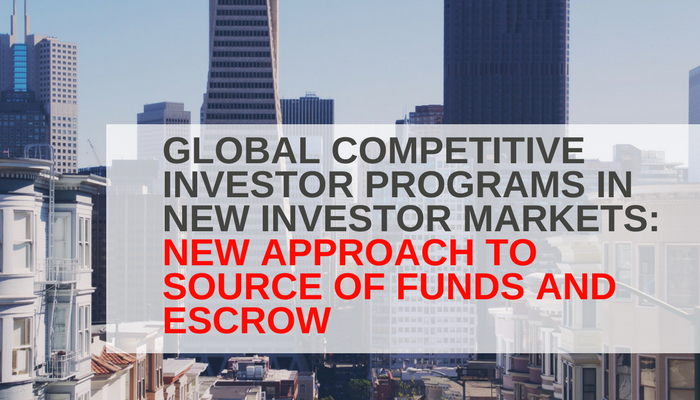Edward C. Beshara
Attorney at Law/Managing Partner, Beshara Global Migration Law Firm
Up until recently, the vast majority of EB-5 Investors in EB-5 Regional Center Projects have been from China. As a result of Chinese retrogression and longtime delay for Chinese Investors to obtain Conditional Permanent Residency, a large number of Chinese are now obtaining Residency by Investment in real estate in other countries.
The EB-5 industry is aware of the competitive residency programs of other countries which attract a substantial number of investors globally. However, the EB-5 industry is still pursuing investors in new markets such as South America, and elsewhere and competing with the other global migration programs (usually Residency by Investment in Real Estate) for the same investors.
The EB-5 industry can recommend a first step to the investors from either China or New Markets to buy U.S. real estate for cash. The financial institutions in the U.S. can provide a mortgage or equity line for U.S.$ 500,000.00 (depending on the cash purchase). The mortgage or equity line will be considered the personal funds of the investor to be invested in the EB-5 project. Possibly the financial institutions will hold the mortgage amounts or equity line in escrow accounts of the bank according to the terms of the agreement to transfer to the NCE (New Commercial Enterprise).
The first step for the EB-5 Investors is to purchase U.S. real estate before the EB-5 investment. This will change the EB-5 industry practices and will lead to the EB-5 program becoming more competitive in New Investor Markets.
The basic structure of the EB-5 Regional Center Program will continue to exist for the EB-5 Investor as the second step.
The EB-5 investment program under a Regional Center designation or license allows one to many foreign nationals to invest their personal funds into a legal and financial infrastructure entity (which may own the land and the buildings to be constructed). The personal investment has to be 100% at risk and no part of the principal investment amount can be exchanged for/or purchase an asset of value such as a condominium or town home.
The EB-5 project will take and use the foreign national investors funds to, in most cases, finance their construction projects, and create indirect jobs. The foreign national investor will first obtain conditional permanent residency then after two years, full or unconditional permanent residency.
Foreign national investors investing in real estate by itself does not lead to U.S. permanent residency.
The U.S. immigration EB-5 Regional Center program has substantial competition from the Residency by Investment programs of other countries.
Foreign national investors can invest in real estate (condos, town homes etc.), in projects in the foreign country, and as a result obtain Residency in a few months (as an example).
How can the U.S. program be competitive?
Foreign national investment in US real estate is substantially increasing. Homes, town homes, condominiums in prime locations are being purchased for cash (or payment in full).
The U.S. today has a solid economy, values are increasing and stabilizing, financial institutions are providing funding or mortgages for homes, and to foreign buyers.
In the U.S., Prime real estate is being sold to the foreign national investor. For example, prime U.S. homes, can be sold at USD $350,000.00 each. Many foreign national investors may decide to buy two homes. In the majority of cases the foreign national investor will pay cash for the U.S. real estate.
With the assistance of U.S. professionals and financial institutions, a mortgage or equity line on the real estate purchased may be obtained.
For instance, the foreign national investor may have purchased two condos at USD $350,000.00 each, for a total of USD $700,00.00. This transaction is independent of the EB-5 investment.
The financial institution may provide a mortgage or equity line of USD $500,000.00 to the foreign national investor. This mortgage amount is considered the personal funds of the foreign national investor, and supports the proof of the lawful source of the personal investment funds and the lawful transfer of the funds.
At this point it is worth noting that the EB-5 program requires personal funds of USD $500,000.00 (the minimum investment amount) to be invested into the EB-5 Regional Center project.
Based upon the facts, the mortgage amount or equity line of USD $500,000.00 can be personally invested in the separate EB-5 project in order to obtain the U.S. permanent residency.
As the EB-5 Regional Center projects enter into new markets besides China, they have to be competitive to attract new investors as explained above. This is the key to the future success of the EB-5 Residency by Investment program in the U.S.
Edward C. Beshara, Attorney at Law/Managing Partner, Beshara Global Migration Law Firm and Adjunct Professor of Business Immigration at the University of Florida College of Law. IIUSA and AILA active member, Referral Partner of NES Financial.
If you are interested in learning more about EB-5 immigration, please contact us today and our experienced EB-5 attorneys will guide you through the process.
Telephone: (407) 571- 6878, Email: ebeshara@besharapa.com, Website: www.besharapa.com

